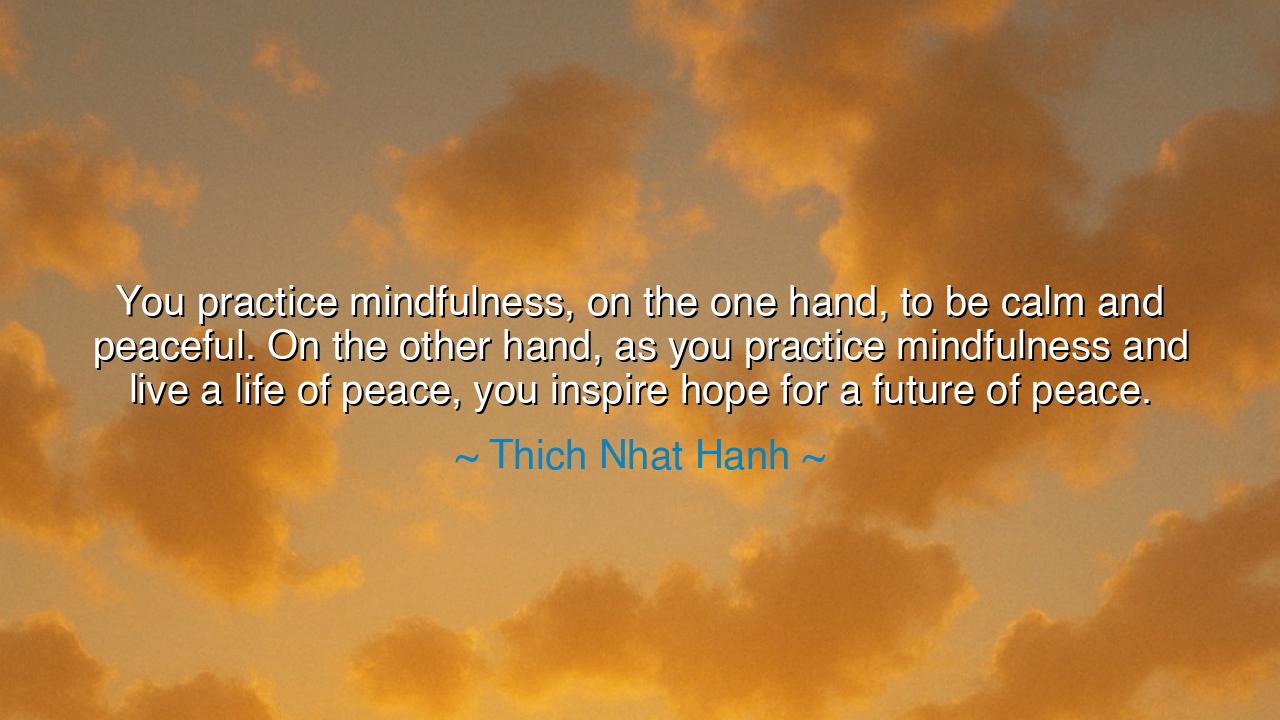
You practice mindfulness, on the one hand, to be calm and
You practice mindfulness, on the one hand, to be calm and peaceful. On the other hand, as you practice mindfulness and live a life of peace, you inspire hope for a future of peace.






"You practice mindfulness, on the one hand, to be calm and peaceful. On the other hand, as you practice mindfulness and live a life of peace, you inspire hope for a future of peace." These profound words from Thich Nhat Hanh, a revered Vietnamese Zen master, remind us of the dual power of mindfulness—a practice that not only nurtures personal tranquility but also ripples outward, inspiring hope and peace in the world. To live a life of mindfulness is to cultivate inner peace, but it is also to serve as a beacon, guiding others toward a future where peace is not just an ideal but a living reality.
In the ancient teachings of the great stoic philosophers, we see a similar emphasis on the power of inner calm to transform not just the individual but the world around them. Epictetus, one of the most influential Stoic philosophers, believed that peace could only be found by cultivating control over one’s own thoughts, actions, and emotions. He argued that our external world may be filled with chaos, but it is only through inner peace that we can navigate it with grace and purpose. Just as Thich Nhat Hanh teaches, the peace one cultivates within oneself becomes a powerful force that can inspire others to seek the same. The peaceful mind becomes a wellspring of hope and possibility for a world caught in turmoil.
The concept of mindfulness and its ability to inspire change has been demonstrated throughout history. Consider the example of Mahatma Gandhi, whose dedication to non-violence and inner peace shaped the course of an entire nation’s struggle for independence. Gandhi’s own commitment to mindfulness and peaceful living inspired millions across India and the world, not just to protest against injustice but to do so with dignity and compassion. His leadership was rooted not in force, but in the inner peace that he embodied, which became a guiding light for others. By living a life of peace, Gandhi sowed the seeds of a future in which freedom and peace could flourish, demonstrating how a single life grounded in mindfulness could ignite a revolution of spirit.
Similarly, Martin Luther King Jr., inspired by Gandhi’s teachings, sought to create a future where people of all races could live in harmony. His message was not one of revenge or hatred but of peace, forgiveness, and non-violence. King’s ability to maintain his mindfulness and inner calm during the most trying moments of the civil rights movement was a direct expression of his belief that lasting change begins in the hearts and minds of individuals. He understood that the only way to create a world of justice and peace was to embody it himself, leading others by example. His legacy, much like that of Gandhi, serves as a powerful reminder that peace—whether in the heart of one individual or in the heart of a nation—is not just an aspiration, but a practice that can shape the future.
The practice of mindfulness has far-reaching effects, for it is not confined to the individual. The calm and peace one cultivates within themselves extends outward, creating a ripple effect that can transform entire communities. In our modern age, where we are bombarded with stress, fear, and constant noise, practicing mindfulness offers a refuge—a way to center ourselves in a world that often feels chaotic. Thich Nhat Hanh encourages us to remember that when we cultivate peace within, we do not only transform our own lives but become ambassadors of hope for a future in which peace prevails. Mindfulness becomes a tool for empowerment, allowing us to face the trials of life with grace, strength, and a deep sense of connection to all beings.
In our own lives, we must recognize the profound influence that living a life of peace can have on the world around us. We are all interconnected, and by nurturing our own peace, we contribute to the larger collective peace of our families, communities, and nations. The lessons of Thich Nhat Hanh and others remind us that mindfulness is not simply a personal practice, but a way of being in the world that can inspire others to seek the same. Each small act of peace—whether it is in a moment of reflection, a kind word, or a compassionate action—ripples outward, creating a future that is shaped by these acts of mindfulness.
The lesson is clear: if we wish to see a world of peace, we must first embody that peace ourselves. Mindfulness is the key to not only transforming our own lives but also to contributing to the greater good. By grounding ourselves in calm, we inspire others to seek the same, and through collective practice, we can create a world that is not only hopeful but peaceful. Let us take this wisdom to heart: to create the future we desire, we must first cultivate it within ourselves. The future is built upon the mindfulness and peace we nurture today.






AAdministratorAdministrator
Welcome, honored guests. Please leave a comment, we will respond soon